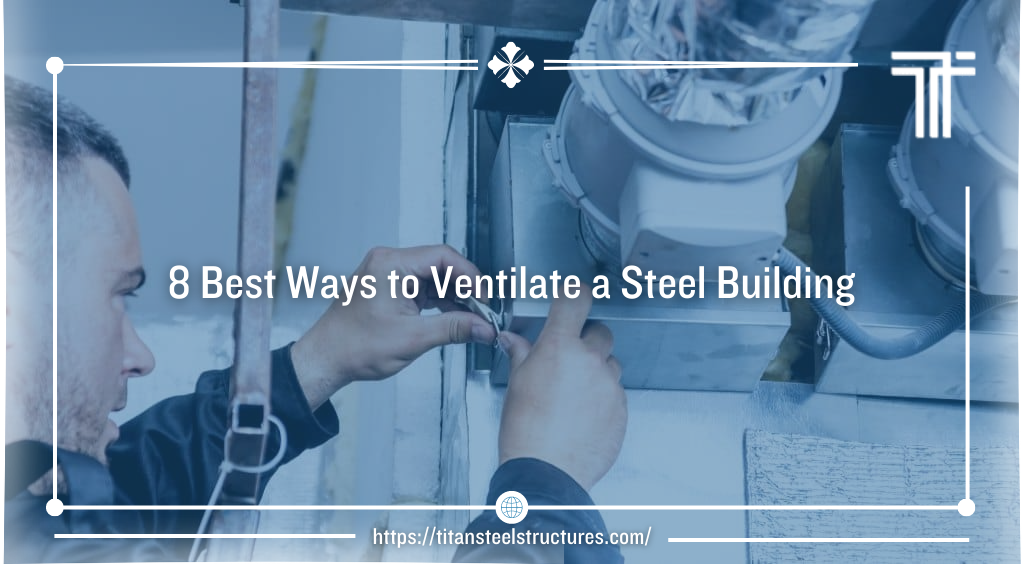The type of ventilation you choose for your steel building depends on various factors, including the climate, your building’s end-use, and its contents. Before planning and construction, you must understand your steel building ventilation options and choose the one that makes sense for your unique project.
Whatever your specifications, the experts at Titan Steel Structures can help you customize the metal building to meet your needs. Contact us today to get a customized quote for your project.
Why is it Important to Ventilate a Steel Building?
There are many factors to consider when planning the construction of your steel building. But one of the most important decisions you’ll make during the process is what kind of ventilation system to use.
Your steel building is an investment that will last for many years. Ventilation allows a steel building to offer the best protection for what’s inside and helps retain the value of the building itself.
But why is it so important to ventilate a steel building? There are several reasons–here are the two most significant.
Preventing condensation
Condensation causes a lot of problems in a steel building. First, it can corrode metal over time and lead to rust. Condensation also leads to mold, which means terrible smells and costly damage. It can cause pest infestation and poor air quality, and it makes it difficult to regulate the temperature inside the building.
To protect your building and its contents, you have to prevent condensation. To prevent condensation in a steel building, you need adequate ventilation.
Maintaining good air quality
Ventilation helps move air throughout your metal building and prevents a buildup of volatile organic compounds and pollutants. The EPA and OSHA set standards for indoor air quality in all commercial and institutional buildings. Adequate ventilation can help meet and maintain those standards and prevent poor air quality in your steel building.
Natural and Active Steel Building Ventilation Options
The methods used to ventilate a steel building are categorized as either natural or active. Natural ventilation options use natural airflow to remove hot, humid, or polluted air from the inside of the building. Some of the benefits of natural steel building ventilation options include:
- Lower energy costs
- Improved air quality
- Fewer maintenance costs
- Reduced carbon footprint
- More consistent temperatures
Natural ventilation methods rely on thermal convection and winds to regulate air temperature and quality, so many building experts suggest adding a hybrid ventilation system to keep air quality consistent.
Active ventilation options utilize mechanical systems to promote airflow. Some of the benefits of an active ventilation system include:
- Regulated temperature
- Consistent ventilation
- Good humidity control
- Improved indoor air quality
The best ventilation option for your building will depend on its intended use, the climate, and other factors.
The 8 Best Steel Building Ventilation Options
You’ll need to consider a variety of factors when choosing how to ventilate a steel building, but knowing more about each option can help you make the right decision.
Here are the eight best steel building ventilation options.
1. Windows
Windows are a natural ventilation option. Placing operable windows at the upper and lower levels of a building can allow fresh air in and humid, polluted air out. As warm, moist air rises up toward the vents, fresh air is pulled into the lower windows.
2. Louvers
Louvers are typically a framed set of moveable blades used to ventilate a steel building. This natural form of ventilation also reduces the impact of wind, noise, and rain.
3. Framed openings
Framed openings with operable doors allow natural ventilation and increase the usability of a steel building.
4. Turbine vents
Turbines use wind energy to pull hot air up and out of a steel building. This natural ventilation option often requires multiple turbines to be effective.
5. Ridge vents
Ridge vents are one of the best steel building ventilation options because they enhance the appearance of the building and provide good airflow along the length of the structure. Ridge vents allow for good passive airflow and are one of the most popular ways to ventilate a steel building.
6. Supply and exhaust fans
Supply and exhaust fans are a form of active ventilation. Supply vents draw outside air into the interior of the building, which forces polluted, humid inside air to the outside. Exhaust fans create negative pressure inside the building. The negative pressure brings fresh outside air into the building via vents and other gaps in the building’s foundation and exterior.
7. Dampers
Dampers are an active ventilation method that helps regulate room-to-room temperature and humidity. Damper valves and plates control airflow in chimneys, variable air volume (VAV) boxes, ducts, and other air-handling components of your ventilation system.
8. HVAC systems
A heating, ventilation, and air conditioning (HVAC) system is an active form of ventilation that gives you outstanding control over the temperature, airflow, and humidity of your steel building. Ductwork, furnaces, air conditioners, and heat pumps are common aspects of HVAC systems used to ventilate a steel building.
Get a Customized Quote
Contact the Titan Steel Structures experts today to get a customized quote for your metal building project. We have a wide range of metal building kits that are ready to be shipped, or you can customize something from the ground up. Our knowledgeable team will help you every step of the way. Get in touch today to get started.

